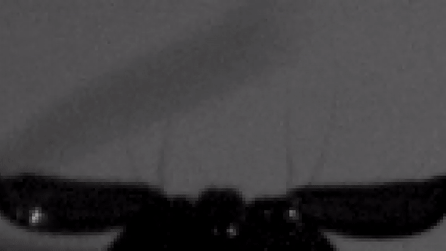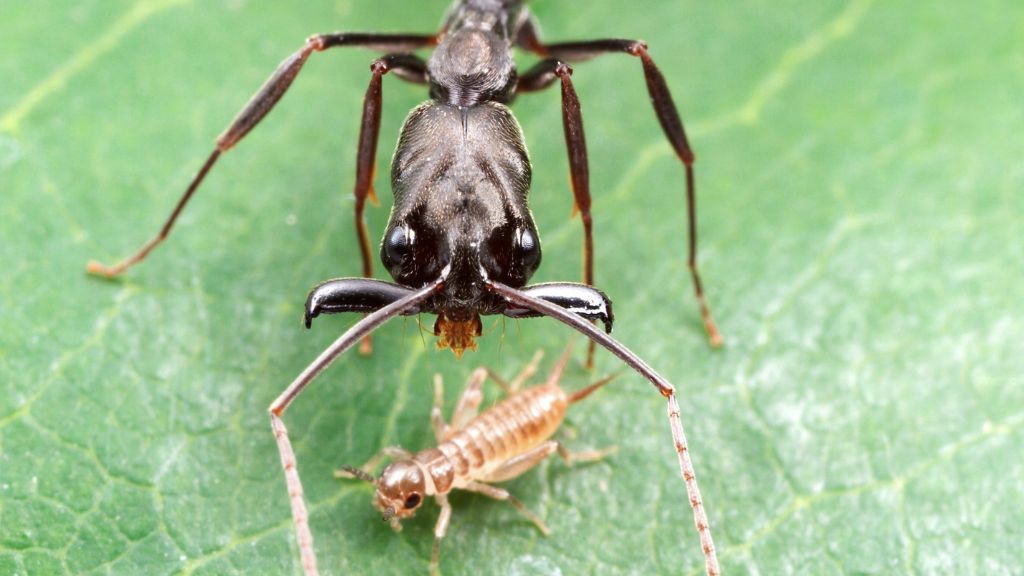Trap-jaw ants' lightning-fast bite should rip their heads apart. Here's why it doesn't.
The ants' jaws reach speeds of 120 mph.

Moving at speeds thousands of times faster than the blink of an eye, the spring-loaded jaws of a trap-jaw ant catch the insect's prey by surprise and can also launch the ant into the air if it aims its chompers at the ground. Now, scientists have revealed how the ant's jaws can snap closed at blistering speeds without shattering from the force.
In a new study, published Thursday (July 21) in the Journal of Experimental Biology, a team of biologists and engineers studied a species of trap-jaw ant called Odontomachus brunneus, native to parts of the U.S., Central America and the West Indies. To build up power for their lightning-fast bites, the ants first stretch their jaws apart, so they form a 180 degree angle, and "cock" them against latches inside their heads. Enormous muscles, attached to each jaw by a tendon-like cord, pull the jaws into place and then flex to build up a store of elastic energy; this flexion is so extreme that it warps the sides of the ant's head, causing them to bow inward, the team found. When the ant strikes, its jaws unlatch and that stored energy gets released at once, sending the jaws smashing together.
The researchers examined this spring-loaded mechanism in fine detail, but the project's engineers puzzled over how the system could work without generating too much friction. Friction would not only slow the jaws down, but would also generate destructive wear-and-tear at each jaw's point of rotation. Using mathematical modeling, they eventually found an answer as to how trap-jaw ants avoid this problem.
"This is the part that engineers are incredibly excited about," in part because the discovery could pave the way for the construction of tiny robots whose parts can rotate with unparalleled speed and precision, Sheila Patek, the Hehmeyer Professor of Biology at Duke University in Durham, North Carolina, and the study's senior author, told Live Science.
Related: What do ants smell like?
A nearly-frictionless, spring-loaded system
To study the incredible jaws of O. brunneus, Patek and her colleagues collected ants from a colony found in the scrubland near Lake Placid, Florida. Back in the lab, the team dissected some of the ants and took detailed measurements and micro-CT scans of their body parts, particularly their jaws and the muscles and exoskeleton of the head. They later plugged these measurements into their mathematical models of the ants' movements.
In addition, the team placed some ants in front of a high-speed camera that captured footage at a whopping 300,000 frames per second. (Video is typically filmed at 24 to 30 frames per second, for comparison.) These videos revealed that, as the ants prepared to strike, the exoskeleton covering their heads underwent significant compression, shortening by about 3%, length-wise, and growing about 6% skinnier around the middle. This compression took place over several seconds, which feels slow compared with the ant's speedy bite, Patek said.
Sign up for the Live Science daily newsletter now
Get the world’s most fascinating discoveries delivered straight to your inbox.
Once released from their latches, the ants' jaws swung through a perfect arc, reaching their peak velocity around the 65 degree mark before beginning to decelerate. At their fastest, the tips of the ants' jaws traveled roughly 120 mph (195 km/h) through the air.
This ultrafast motion unfolded smoothly and precisely thanks to several forces acting on the jaws at the same time, the team determined.

For one, as the ant's head popped back into its normal shape, it catapulted the tip of each jaw out into space. Meanwhile, the large muscles inside the ant's head relaxed and stopped stretching out the tendon-like cords to which they were attached. As each cord settled back to its normal length — think of a stretched-out rubber band suddenly being released — it yanked on the end of the jaw that sits inside the ant's head. It's this simultaneous pushing and pulling that sent the ant's jaws flying towards one another.
Related: These worker ants drag their queens to far-off bachelor pads to mate
A similar principle applies when you spin a bottle on a flat surface; the twisting motion required to spin the bottle involves pushing one end of the bottle forward while pulling the other end backwards. Likewise, when ballerinas perform pirouettes with the support of a partner, the partner will push one of her hips forward and pull the other back to set her turn in motion. However, the best analogy for the trap jaw ant's mandible motion might be stick juggling, a circus art in which performers use two sticks to twirl a baton in mid-air.
The baton encounters little friction as it flips through the air, and based on their mathematical models, the study authors think that a trap-jaw ant's mandibles are similarly unconstrained. At first, the researchers thought that each jaw might pivot around a pin joint, similar to a door on a hinge, but they determined that such a structure would introduce too much resistance. Instead, they found that the jaws rotate around a far less rigid joint structure that requires little reinforcement in the ant's head.
"The dual spring mechanism drastically reduces reaction forces and friction at this joint so that the joint does not need very much reinforcement in order to hold the mandible in place," study co-first author Gregory Sutton, a Royal Society University Research Fellow at the University of Lincoln in England, told Live Science in an email. The lack of friction in this system may explain how trap-jaw ants can strike again and again without ever injuring themselves, the authors concluded.
The authors think that all trap-jaw ants in the Odontomachus genus use the same spring-loaded mechanism to bite, but trap-jaw ants in other genera may use a slightly different strategy, Patek said. That said, Patek suspects that the mechanism they discovered may well be used by other arthropods, meaning insects, spiders and crustaceans.
For example, mantis shrimp, famous for throwing 50 mph (80 km/h) punches, likely warp their exoskeletons and use super-stretchy tendons to build up power for each strike — although such a mechanism has not yet been identified in the shrimp.
"We're starting to realize that this is going to be the rule of thumb for these super-fast arthropods," Patek said.
Originally published on Live Science.

Nicoletta Lanese is the health channel editor at Live Science and was previously a news editor and staff writer at the site. She holds a graduate certificate in science communication from UC Santa Cruz and degrees in neuroscience and dance from the University of Florida. Her work has appeared in The Scientist, Science News, the Mercury News, Mongabay and Stanford Medicine Magazine, among other outlets. Based in NYC, she also remains heavily involved in dance and performs in local choreographers' work.










